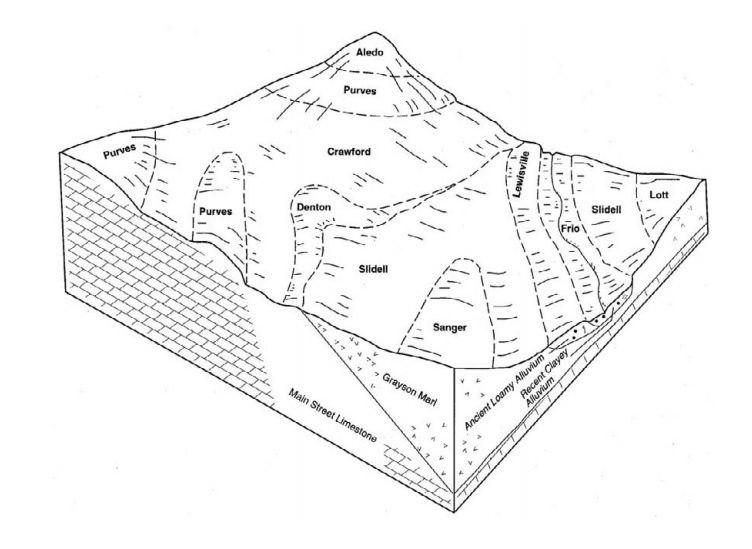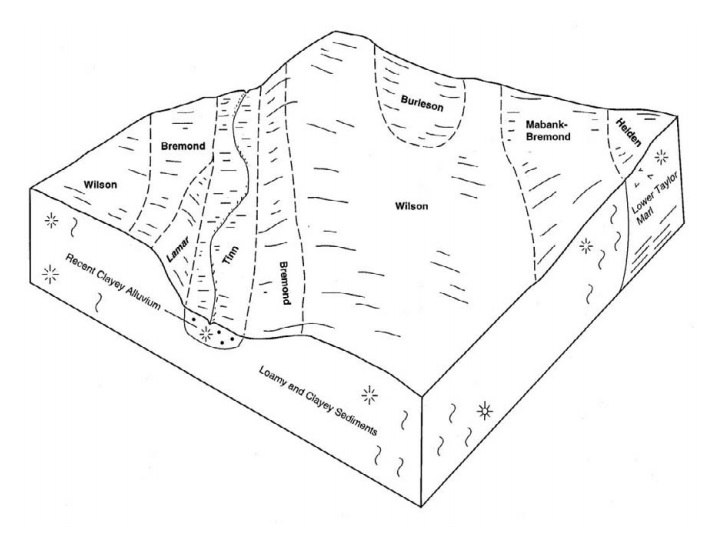Click here for how to find an EarthCache
The Waco Mammoth Site became a National Monument under the auspices of the National Park Service, Friday 10 July 2015. Several of the mammoth remains rest in-situ at the site. How they came to be there is due in large part to the soils of McLennan County.
Soil can move about and come to rest in different areas for different reasons--sandstorms (like the Dust Bowl in the 1920s), floods (similar to Texas' 2015 rains), plate collisions and shifts (creating earthquakes and rifts) are just a few examples. Due to a shifting of soils, Waco Mammoth National Monument came to be. Discover what caused these area soils to shift, what types of soils came to rest upon one another, and what happened as a result of the shifting soils. Use the diagrams on the cache page and the guided tour to answer the questions about soils in this region of McLennan County. You will need to take the tour to answer the questions and see the dig shelter.
Questions to answer in order to log this cache
#1. What Columbian Mammoth features do you learn about at Waystop 2, near the Amphitheater?
#2. What was discovered at Waystop 3, the bridge prior to the Dig Shelter?
#3. You should be in the Dig Shelter. Based upon what you see and the soil characteristics in the description, how many flood plains were there?
#4. How did Mammoth Q come to rest here?
#5. What about the soil prevents scientists from determining if Mammoth W and Mammoth T are related?
Please Message me your answers prior to logging your find. Any logs posted without submitted answers will be deleted.
Soil Terminology
Alluvium. Material, such as sand, silt, or clay, deposited on land by streams.
Clay. As a soil separate, the mineral soil particles less than 0.002 millimeter in diameter. As a soil textural class, soil material that is 40 percent or more clay, less than 45 percent sand, and less than 40 percent silt.
Claypan. A slowly permeable soil horizon that contains much more clay than the horizons above it. A claypan is commonly hard when dry and plastic or stiff when wet.
Friable. Easily crumbled or reduced to powder; crumbly.
Illuviation. The movement of soil material from one horizon to another in the soil profile. Generally, material is removed from an upper horizon and deposited in a lower horizon.
Loam. Soil material that is 7 to 27 percent clay particles, 28 to 50 percent silt particles, and less than 52 percent sand particles.
Marl. An earthy, unconsolidated deposit consisting chiefly of calcium carbonate mixed with clay in approximately equal amounts.
Ped. An individual natural soil aggregate, such as a granule, a prism, or a block.
Root zone. The part of the soil that can be penetrated by plant roots.
Terrace. An embankment, or ridge, constructed across sloping soils on the contour or at a slight angle to the contour. The terrace intercepts surface runoff so that water soaks into the soil or flows slowly to a prepared outlet. A terrace in a field generally is built so that the field can be farmed. A terrace intended mainly for drainage has a deep channel that is maintained in permanent sod.
Terrace (geologic). An old alluvial plain, ordinarily flat or undulating, bordering a river, a lake, or the sea.
Topsoil. The upper part of the soil, which is the most favorable material for plant growth. It is ordinarily rich in organic matter.
Upland. Land at a higher elevation, in general, than the alluvial plain or stream terrace; land above the lowlands along streams
Description
The Waco Mammoth Site rests in a shallow ravine surrounded by terraces north of the Bosque River and south of the Brazos River bi-sected by the Blackland Prairie to the east and the Grand Prairie to the west.

Similar to today, the soils produced a landscape that included grassland prairies and oak savannahs surrounded by river flood plains. Geologists and paleontologists have observed these specific soil series at Waco Mammoth Site: Frio, Burleson, Wilson, Lewisville, and Sunev.
Soil Series Characteristics
Frio Series The Frio series consists of very deep, nearly level, well drained, clayey soils on flood plains. These soils formed in loamy and clayey, calcareous alluvium of Holocene age. These soils are moderately alkaline and effervescent throughout. The texture is stratified alluvial clay, clay loam, silty clay, or silty clay loam. The content of clay ranges from 35 to 50 percent. The depth to sand, gravel, or limestone ranges from 6 to more than 30 feet. The A horizon is brown, dark brown, grayish brown, dark grayish brown, or very dark grayish brown.
Burleson Series The Burleson series consists of very deep, nearly level, moderately well drained, clayey soils on stream terraces of Pleistocene age. These soils formed in clayey alluvium.
Wilson Series The Wilson series consists of very deep, nearly level or gently sloping, moderately well drained, loamy soils on uplands. These soils formed in clayey sediments.
Lewisville Series The Lewisville series consists of very deep, gently sloping, well drained, clayey soils on the lower terraces of Pleistocene-age (fig. 20). These soils formed in calcareous, clayey alluvial sediments.
Sunev Series The Sunev series consists of very deep, gently sloping, well drained, loamy soils on low terraces and in filled valleys of Pleistocene age (fig. 26). These soils formed in calcareous, loamy sediments along drainageways.
Soil Distributions Maps


| I have earned GSA's highest level: |
 |

| Congratulations to Jungle-jim8008 on FTF! |